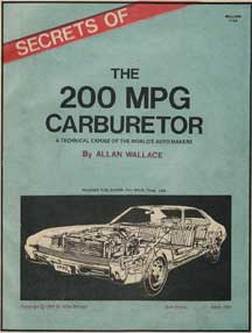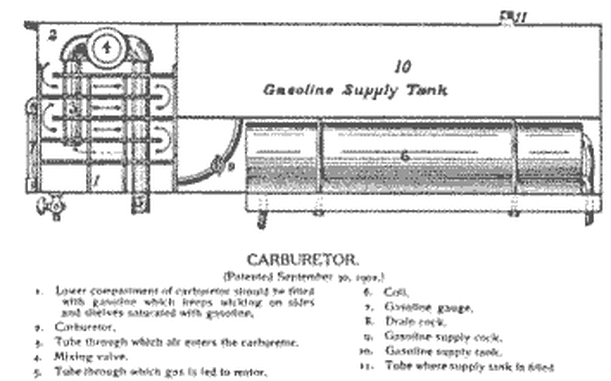
For years I've been hearing about fantastic carburetors that can give your car up to 200 mpg. But supposedly the automakers and Big Oil won't allow them to come to market because they'd wreck the industry. The people who tell you this are usually conspiracy buffs who offer it as an example of how the masses are duped by the Illuminati, so you have to be skeptical. But still I wonder: is the 200-mpg carburetor a complete fantasy, or does something like it actually exist? Do you have one on your car? Would you like one?
Here's the free PDF for 200MPG Carburetor Conversion hosted by Apparently Apparel and written by Allan Wallace, just for you! NOTE: This is a big (57975kb) file so please be patient and allow up to 10 minutes download time depending on your connection speed. Anyways, while that downloads, read what we found out about improved carburetors and automobiles that prompted the writing of this article. 1933 thru 1936 - Charles Nelson Pogue is issued several patents on his vaporizer type carburetors, and "claims of 200 miles per gallon" crop up all over the world. He never gets production off the ground and his carburetor fades away - But Mr. Pogue and his carburetor have been a legend in the field of fuel efficiency ever since. More than 50 years ago - George Arlington Moore was issued more patents on fuel efficiency systems than any man in history to date. The late 50's and early 60's - The Kendig and Fish variable venturi carburetors have some very interesting mileage figures. The Fish even gets into production on a very small scale - but for reasons unknown, both of these carburetors fade away over the next few years. 1968 - Ford Motor Company begins experiments with an engine that has a different kind of combustion chamber. A fuel injected version of 430 cid is tested and runs very well on an Air/Fuel mixture of 26:1 - Ford experimented with this engine for possible production by 1985 - Obviously it was never put into production. 1973 - The annual Shell Oil Company employees contest turns out a world record for high mileage at Wood River, Illinois. A highly modified Opel of 1959 vintage sets the record with 376.59 miles per gallon - World record mileage is now well over 2,000 miles per gallon from very specialized vehicles designed to do one thing - get the most mileage possible. 1974 - An article from "Mechanix Illustrated", about Humidifier Type Fuel Systems, tells of a man by the name of LaPan - who claims to get from "60 to 100 miles per gallon" with his system. 1976 - A modified Ford Pinto equipped with a turbocharged Nissan diesel engine is tested and gets up to 80 miles per gallon. 1977 - Tom Ogle, of El Paso, Texas, claims to get 100 miles per gallon on his 1970 Ford Galaxie with V-8 engine, weighing 4600 lb. Running one round trip test from El Paso, Texas to Demming, New Mexico and back used only two gallons of gas. His Vapor Fuel System eliminates the standard carburetor, only has a three gallon tank, and emits no carbon dioxide or unburned hydrocarbons. 1977 - A standard VW Rabbit diesel with turbocharger, is independently tested and gets up to 55 miles per gallon. 1978 - The Flex Gas Vaporizer -(as advertised in national magazines)- and sells for a reasonable price, claims to double gas mileage from most any car - and gets to 110 MPG on some... The FLEX GAS VAPORIZER developed by ONMEWTRONICS of Carson City, NV was being distributed by: Van M. Polowchak - 111 Pine - Fort Morgan, CO 80701 - Recent inquiries have gone unanswered. 1979 - Ralph Moody Jr., of Oak Hill, Florida, gets 84 miles per gallon from his modified Ford Capri, which has been equipped with a turbocharged 4-cyl Perkins diesel engine. Are all these stories true..? You bet they are, and these are just a few of the thousands we haven't even mentioned yet!- There are many many more. Many thousands of backyard inventors have come up with systems that get a much better efficiency from gasoline than does the modern carburetor or fuel injection, and a few have built systems that get a drastic increase. The phantom carburetor of Charles Pogue has disappeared from the public eye, and re-appeared many times over the past 60 years or so. Every few years some rumors and stories begin to circulate about someone trying to manufacture and market the carburetor, but for some unknown reason the stories die out and the carburetor never makes it to market. Many people have built the Pogue and some have been very successful. A letter from Mr. Gail Dye of Benton, IL - claims that he has been offered a $100,000 a year job to quit playing around with these things. We haven't heard from him since - Maybe he took the job.? Another letter from a Bill Stewart Wood of Nestor, CA says that he and a partner built a Pogue Carburetor about 25 years ago - but after having some problems with it, and no money to continue working on it, shelved the project and never got back to it. A man in Richardson, TX was selling plans to a carburetor modeled after the Pogue but used in conjunction with the standard carburetor for starting and cold running. An automatic thermostat switches over to the Pogue type carburetor when temperature is hot enough to vaporize the fuel. Upper chamber is 5 inches high and 7 inches diameter, lower chamber is 2 inches deep and 4 inches diameter. He claims to have installed the device on a Lincoln and has obtained up to 100 miles per gallon. He was doing business as: FUELMIZER - Box 6025 - Richardson, TX 75080 - Recent inquiries go unanswered... John Wesling - Preston, MN worked on his idea to use both heat and vacuum, with a device made up of modified carburetor parts and a heat exchanger to double his mileage in 1981. Joe Lasante - Bossano, Alberta, Canada was working on a system he said works quite well and is simple to make. He says he can get at least 30 MPG on his 1978 Dodge pickup with a 360 cid V-8 engine. The engine runs Very smooth and it has more power than it did without the modification. Ken MacNeill, Box 9478, Winter Haven, FL says he can effectively double the mileage of Most Any Car. Richard Goranflo, 109 Longleaf Lane, Altamont Springs, FL once gave seminars on the subject of high mileage - And claims to get from 45 MPG to 65 MPG on his 1976 Cadillac with 425 cid V-8 engine. Bernard Wherry, Box 148, St Marys, WV - worked on his high mileage carburetor design for many years. He eventually ended up with three prototypes. With one giving him 60 MPG on a Chrysler with V-8 engine. He wanted to market the carburetors, but without the necessary financing he was unable to do so. He had turned over the designs to a firm who "claimed" they would market one of the three designs, but to date the Wherry carburetors are not on the market. John Draper of Crofton, MD - Once fed all the info available on the characteristics of gasoline into a computer, and then fed in all the info he could get on the Pogue Carburetor - And asked if the Pogue would work. The computer said it would indeed. Ray Covey of El Paso, TX - worked on a high mileage carburetor modeled after a Sgrignoli design for over a year, and ended up getting 65 MPG on his Chrysler V-8 with an occasional 100 MPG. After applying for a patent, Covey began marketing plans to his device and installed several units for a few of his customers. Covey built another design similar to a Ford Motor Company patent and started marketing plans to the new design too. Covey seems to be able to take ideas from others and make them work very well - To our knowledge, he has no original ideas of his own in the field of high mileage carburetion, but he seems to does do very well with the ideas of others. Richard Paul, Janesville, WI - Averages 80 MPG on his Oldsmobile Toronado, and says he has achieved as high as "149 MPG" on more than one occasion. He says he expects to top 180 MPG with the newest design he is working on. Herb Hansen - Elgin, IL - Built a vaporizing carburetion system for use with alcohol Fuel. Using 140 proof alcohol in a Ford Pinto he says he gets 70 to 75 MPG and the engine produces "more power" than it does on gasoline with a standard carburetor. Fred Holste of Jarrettsville, MD - Claims to have topped 45 MPG with his design for a vapor carburetor. He says he will deny having done so if we print his name though. John G Mesal of Wrightwood, CA - Built his own version of the Pogue carburetor and obtained excellent results for both engine power and smoothness... But was unsuccessful at increasing mileage. Jim Fouler. formerly of Cortez, CO - Built one prototype of his own design. He too was unsuccessful in gaining a mileage increase, but he continues to work at it. Ivan Pinivta of St Norbert, Alberta, Canada - Once claimed to own an original Pogue Carburetor, and even had it up for sale. We offered him $5,000 for it - if it was the real thing - he refused our offer. He eventually took it to a Canadian News Agency where tests were made and an article written about it. The device is in reality a "Winnipeg Carburetor" - one of 200 built - and Not a genuine Pogue Carburetor at all - Mileage was about 35 to 45 miles per gallon. So, as always, what do you think? With the following video, it seems like even the police are using alternative engines in these trying times. Personally, I think it's time to upgrade to anti-grav already, get rid of roads altogether and make gardens and farms instead. Plant some hemp to regenerate (instead of deplete) the soil, rid the air and land of radiation, and help promote peace on this planet, instead of the current status quo. Leave your thoughts below, and have a great day. Zach Royer, Author & Independent Researcher http://www.ZachRoyer.com Source(s) 1 2 3 To Read More, Please download the 200MPG Carburetor .PDF <---- Please consider sharing this article using the buttons below...Mahalo!
36 Comments
Petergrote1911
9/21/2013 10:48:39 am
We build HHO Dry-Cells Here in South Africa. Full 316 L Stainless Steel Construction.
Reply
Old Mike
4/12/2014 09:16:58 am
OK so lets get simple. Did you ever use a gasoline Coleman Stove while camping? It has a small pump to pressureize the fuel tank, a gas generator that sits on top of one of the burners, and is easy to light and operate. It uses the heat of the flame to generate the gas that is used to fuel the burners. A system like this could supply well vaporized gas fumes to feed a carburator, and using a small tank with a high pressure chemical pump to keep the small tank full and pressurized is all you need to create your very own high milege system. The gas generator is placed through the exhaust manifold to get its needed heat, and then the gas generator line is run to the intake manifold. The only problem is figuring out how to throttle the output effectively. It would work best with a constant speed engine or generator. Alternately, patented in 1952 was a system using supercritical fuel injection.It was used in diesel powered power plants to reduce fuel consumption to 1/10th the normal rate, allowing power generation companies to increase profits, without telling the public what they had done. It can also be used in gasoline powered engines with some more safeguards added. It simply uses a high pressure pump to feed a small fuel injector that is made from high strength high temperature material. The fuel injector is heated to about 800 degrees using a small electrical heating element. The injector then opens and only gaseous state fuel comes out, no liquid. At this temperature called the critical temperature, gasoline is uncapable of existing as a liquid. A small anti back flow valve is used to protect against backfires into the fuel injector and pump system. The injection is controlled by a computer and a feedback system with an oxygen sensor. SO little gas is used that a catalytic converter is not necessary. There are so many ways to skin the canary! Alternately the use of a vacuum pump to vaporize the gasoline at lower temperatures would work just using the water jacket heat of the engine to preheat the fuel. As you know boiling gasoline in a vacuum makes the gas get cold, so some heat has to be continually added to make it vaporize.
Reply
Prof. Walter
10/8/2016 11:24:34 pm
I remember my parents had one of those stoves and we stopped using it in Brazil because it called for white Gas and we did not know if we could use regular gasoline instead.
Reply
VonBraun
10/5/2015 01:03:21 pm
We made a spiral container about 5 inches tall and about 3 feet in diameter with 7 turns of the spiral inside the container. About 25% of the container has liquid gas in it and the upper 75% has just air space. As the motor sucks in air through the spiral it mixes with gasoline fumes until it reaches a perfect ratio of fumes to air which is acheived by the time the air reaches the center of the spiral. Once at the center of the spiral which is located at the center of the container the air then goes through a hole in the center and up a vacuum hose which goes to the throttle body intake and then into the engine where it is detonated. A chevy 350 in a full sized truck gets 240 mpg in the city. We also have an AR15 loaded and ready to use on anyone who comes to threaten. us or tries to shut us up by. Killing us. The best of both worlds. We dont care who it is or what agency they are from...if we are threatened then boom they die. Now thats how you take care of an arrogant oil company...40 of our armedm men against 5 of theirs. We win.
Reply
cpufreak101
1/20/2016 01:13:56 am
by any chance would you feel like giving a diagram of your device, just from your description i have a general idea of how it works, but far from enough to build one, and i can understand you can be scared of me being someone whose going to trace your IP address and kill you, so to try to disprove that, you ever hear of a program called torchat? 100% anonymous, untraceable chats, my ID is fp3tt7qe2gmphfmv send me a message there
Reply
Disgruntled Hippie
4/6/2016 11:22:14 pm
Ever hear anything? I'm curious and would like to try it out.
cpufreak101
12/19/2016 05:09:14 am
Disgruntled Hippie, no sadly, plus that Torchat link i gave is dead, posted the wrong one to begin with and now i don't even have the PC that was installed to anymore
Benjamin
5/14/2016 10:51:20 pm
please send us diagram of your device, we also want to fight this corapption and fuel gasslers.
Reply
7/6/2016 01:41:25 pm
Hi, I would like to learn more about what you have accomplished, we are not associated with any organization. Just ourselves living off grid since 1999, we would put the information to work on generators, our personal vehicles. I am not interested in marketing any of it.
Reply
cpufreak101
12/19/2016 05:10:37 am
did you get any info out of curiosity? if so please e-mail me, [email protected]. I also have no plans to commercialize or profit from the info in any way.
Prof. Walter
10/8/2016 11:18:44 pm
I need economy in the Amazon Jungle. Please send me plans and parts list. Does it also work on injection systems?
Reply
Frank
11/18/2016 03:20:16 am
Excellent work I have been struggling with how to get enough vapour off the fuel and your spiral channels the answer do you also use baffles so fuel doesn't slosh around when cornering,braking or accelerating
Reply
Jim Hadfield
10/21/2015 08:09:38 am
I personally knew Nelson Pogue years ago... He was a member of our church, altho relatively recluse and refused to discuss anything about his carburetor.
Reply
Rob Thomas
3/2/2016 08:12:14 pm
Hi Jim,
Reply
Pepeg
4/7/2016 08:55:41 am
Hello Jim,
Reply
Pete Maloy
4/9/2016 07:23:06 pm
Definitely interested if you have more to share than the PDF document I found on this website titled Secrets of the 200mpg Carburetor by Allan Wallace (printed 1982).
Reply
JJ Buchholz
6/28/2016 08:10:04 pm
I am also interested, but unsure how to make contact with you. Thanks
Reply
Frank
11/18/2016 03:23:19 am
Would love to hear more about what happened with Mr Pogues and his invention
Reply
cpufreak101
12/19/2016 05:12:29 am
Hello, i am interested in more information, could you either give a comment below or send me an e-mail at [email protected]? if you request a more secure platform we can make arrangements
Reply
Ahmed Shokr
10/6/2017 11:55:50 am
hi ..mrJim
Reply
Bradley R Seabern
7/12/2016 04:26:43 am
ray sold insurance for me he told this that he had a carb that got 100 plus per gallon i know it was true there was another person named wardy that was his friend he told me over and over about this and he told me about the threats brad
Reply
Casey Derrickson
9/11/2016 03:56:49 am
Please send me the info I am a machinist and I guess u could say want to be engineer that actually could make a cad/cam program that would be easily built. Thank u for your time and attention
Reply
Tony Girona
9/27/2016 01:45:39 am
Im 63 yrs old and i make one vapor with bubble, but the gas doesn't work for too long. I'm very interesting in more information.
Reply
9/4/2017 04:42:15 am
you may want to give this link a try too.
Reply
Mike
10/1/2016 04:39:37 am
i had an idea to install a fuel hose coming from the PCV valve on my 1994 toyota corolla, that hose goes to a bubbler (a gas tank from a weed wacker filled at the bottom with liquid gasoline), the vapor kicked up by the positive pressure coming from the crankcase would go along another fuel hose that i wound several times around the upper radiator hose to heat the fuel vapor before it makes its way into the intake manifold where normally the PCV hose would go. i installed a flashback arrestor on the hose right before the intake manifold
Reply
Frank
11/18/2016 03:14:28 am
I believe you need the air to be warm across the gasoline and you will need a larger surface area of gasoline that's how the gentleman with the truck is successful because he's channelling the air across a large surface area hence the 3 foot diameter spiral tube
Reply
9/4/2017 04:49:18 am
look up EFIE module and how it corrects what your ECM is doing from listed website...cheers
Reply
9/4/2017 04:55:35 am
"i just want to help people stop getting ripped off"
Reply
Dedi
10/25/2016 02:28:58 am
Reply
Scott
12/19/2016 02:54:40 am
Could you please send me plans on vapour carp convertion. I love saving money and am very interested. Thank-you and God bless you.
Reply
Brandon
4/4/2017 01:20:20 am
Hi Guys I'm a back yard inventor from Australia, Recently I made a breakthrough using a combination of a fuel vapourising system combined with a hydrogen on demand system to heat the vapourising chamber and provide both hydrogen and vapourised fuel directly injected into a 5lt v8 engine. the engine is not in a car so I can not give an estimate on kilometres per litre though a 600ml bottle of 95 octane petrol in conjunction with the HOD system will power a 20kva generator at 2200 rpm for between 5-6 hours (8 hours being the best test so far). im having trouble with injectors and have modified several different types with some ok results. my question is: where could I find information regarding anything that could help me as everything I read seems to be miss information or just total nonsence. thanks in advance. Brandon.
Reply
Richard
4/14/2017 07:21:36 am
What do you mean by injector problems, exactly?
Reply
Brendan
7/30/2017 12:37:03 am
Hi there my name is Brendan have you thought of using the injectors used in the LPG direct injection gas system the only difference should only be its a fuel vapour instead of LPG
Reply
Your comment will be posted after it is approved.
Leave a Reply. |
News Watch
Mind-opening news articles, editorials, videos & apparel that inspire our readers and help liberate them from the status quo. Stay informed.
Write For UsSpace WatchTop NewsNews Watch Categories
All
|
|
|
HAVE A TIP OR STORY TO TELL? JOIN TODAY & SHARE YOUR STORY!
If you have a breaking news tip or idea, please email: [email protected] Apparently Apparel® is a registered trade name and part of the ZOAT International® brands network. © 2007-2023. All Rights Reserved. Privacy Policy. All art & news content posted on this site is commentary or opinion and is protected under Free Speech. ApparentlyApparel.com is not responsible for content written by contributing artists, authors or news feeds. The information on this site is provided for educational and entertainment purposes only. It is not intended as a substitute for professional advice of any kind. ApparentlyApparel.com assumes no responsibility for the use or misuse of this material.
|
|








